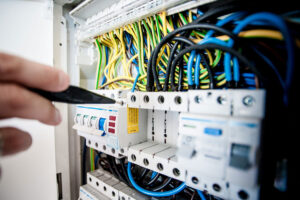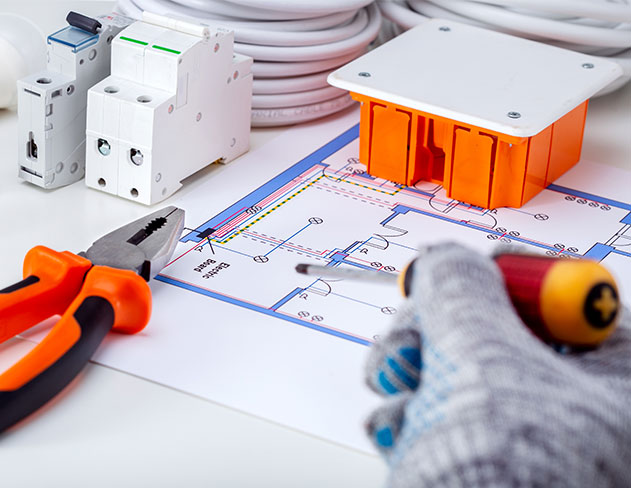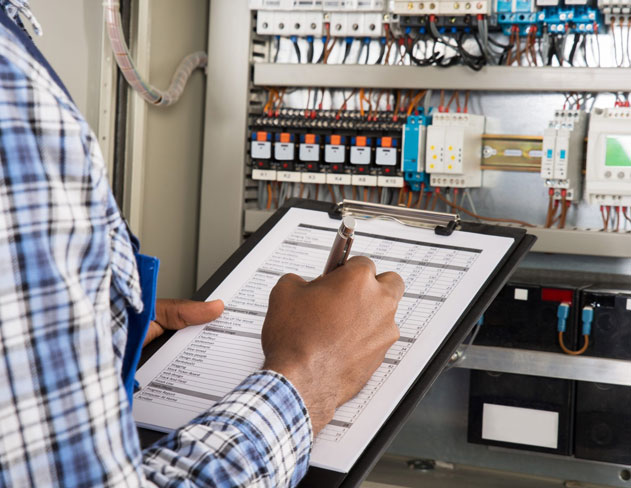
Welcome to our complete guide to Commercial EICR – all you need to know to stay safe, and compliant as a business owner or facilities manager. Electrical safety is of paramount importance for any business or commercial property. A commercial EICR provides a detailed inspection of the electrical installations, wiring systems and equipment at commercial premises. This comprehensive guide will explain everything commercial property owners and managers need to know about EICRs.
What is a Commercial EICR?
A Commercial EICR is a thorough visual inspection and testing of all the existing electrical wiring and installations at business premises like shops, offices, warehouses, factories, hotels and other commercial buildings. It differs from domestic EICRs meant for residential homes in terms of its wider scope and complexity – commercial properties often span much larger areas and feature more intricate electrical systems powering diverse needs
A professional commercial EICR inspection aims to identify any deficiencies, wear and tear, defects, overloaded circuits or other issues with the electrical installations at a commercial facility that may pose a safety hazard.
The electrician carrying out the EICR will methodically check all fixed wiring and electrical equipment such as the main supply, submains, distribution boards, sockets, switches, lighting circuits and so on to ascertain if they meet the latest IET Wiring Regulations and electrical safety standards.
The EICR will also clearly highlight any remedial actions required to fix any issues or risks identified during inspection and testing to make the electrical installations safe. Facility managers can promptly address the faults before they lead to accidents or fires. Regular, periodic EICR inspections and testing are a legal requirement for commercial property under health and safety legislation, including the Electricity at Work Regulations.
An EICR provides the most crucial insight into the current state of electrical safety at commercial premises. No business or commercial property owner can afford to overlook this key legal obligation.
Key Differences Between Commercial and Domestic EICRs
While the overall purpose of assessing electrical safety is the same, Commercial EICRs have some specific differences from Domestic EICRs meant for homes:
- Broader scope – Commercial EICRs need to cover an entire business premises that is usually much larger than a typical residential home. The wiring systems are more extensive, powering diverse business equipment and machinery across large areas and multiple floors/buildings.
- Higher complexity – Electrical installations at commercial facilities are more complex than homes, with larger distribution boards, submain systems, multiple circuits, emergency backup systems etc. catering to the electrical requirements of the business operations. Specialist equipment and dedicated power circuits are often involved.
- Stringent standards – Although domestic properties must also comply with IET wiring regulations, the compliance requirements for commercial properties are more stringent owing to higher fire and safety risks. Commercial EICRs must also conform to additional standards and legal obligations around public liability, employer duty of care, insurance stipulations etc.
- Specialist inspectors – While domestic EICRs may be conducted by general electricians, commercial EICRs require NICEIC / ELECSA / NAPIT-approved inspectors specially qualified and experienced in assessing complex electrical systems at workplaces and business premises through thorough visual scrutiny and testing.
- Frequent inspections – Commercial properties usually require EICR inspections much more frequently than the 10 year intervals common in homes. Annually or every 3-5 years is typical for high-risk environments like factories and warehouses.
- Higher stakes – Electrical faults at a business facility can impact the continuity of essential operations, lead to employee injuries or fatalities, and result in much more severe financial, compliance and reputation damages. Hence rigorous periodic inspections are indispensable.
Why Regular Commercial EICR is Essential
While some business owners mistakenly perceive EICRs as an avoidable nuisance or cost, they are in fact an indispensable requirement for running a legally compliant, safe commercial facility. Some key reasons why periodic professional EICR is mandatory:
- Electrical Safety
Faulty electrical installations are the cause behind many workplace accidents and fires annually. Before disaster strikes, an expert EICR inspection can identify risks like faulty wiring, overloaded circuits, and malfunctioning equipment. Promptly fixing or upgrading any medium to high risk defects highlighted in the report makes the premises safer for employees, customers and assets.
- Legal Compliance
EICR testing is explicitly mandated under several electrical safety legislations and standards commercial property owners must comply with. These include the Electricity at Work Regulations, the Building Regulations, the Regulatory Reform (Fire Safety) Order 2005, the Health and Safety at Work Act 1974 and the ISO 9001 Quality Standard. Failure to ensure up-to-date EICR compliance as required can lead to heavy penalties, prosecution and even imprisonment in cases of severe lapses leading to serious accidents. Even minor contraventions like missing certificates can lead to sanctions and delays in securing insurance.
- Insurance Requirements
Most insurance providers now require valid, up-to-date EICR test certificates as a prerequisite for businesses and commercial buildings underwriting policies. Policies can be invalidated even retroactively if serious unaddressed safety issues indicate negligence – the repercussions of which can be huge in case of major incidents. Periodic EICR is a key part of demonstrating compliance and duty of care.
- Reputational Risk Mitigation
While the most dangerous consequence of non-compliant electrical installations is loss of life and property, even near misses, minor incidents or whistleblowing by staff can lead to expensive lawsuits, negative publicity in traditional and social media, loss of customer trust and permanent reputational damage for both the facility and its management. A robust regime of periodic EICRs and quick resolution of identified issues proactively mitigates these risks.
- Lower Long Term Costs
Business owners sometimes hesitate seeing EICRs as an avoidable cost but regular inspection can in fact help avoid far more expensive damage from electrical faults down the line. The cost of a full commercial EICR inspection from a certified provider generally ranges from £169 – £400 depending on the property size and location. Fixing issues early is much cheaper than dealing with the disastrous financial, legal and PR consequences of accidents, fires or large-scale systems failure that can run into millions. Prevention is more prudent than cure.
The Inspection Process Explained
The first step in the EICR process is picking a qualified and experienced electrical inspector approved by NICEIC or ELECSA or NAPIT for the actual inspection. But before that, the property owner or facilities manager must ensure the facility is ready for the inspection through several preparation steps outlined later.
Once an accredited provider is selected, here is an overview of the key stages involved in a professional EICR inspection:
- Detailed Visual Examination
The inspector will first perform a painstaking visual examination of all electrical installation parts. This includes:
- All switches, sockets, fuse boxes and light fixtures
- Distribution boards, main switchboard and meter
- Fixed wiring, cables, junction boxes, trunking and conduits
- All accessible connections, joints, terminations and insulation
All components are checked for any signs of damage, deterioration, loose fittings, overloading, overheating and other visible defects that may indicate potential hazards.
- Rigorous Testing
The next stage is rigorous electrical testing of the circuits and equipment as per the latest IET Wiring Regulations and BS 7671 standards. Different types of tests conducted include:
- Continuity Testing – Verifies all electrical connections have low resistance to ensure effective and safe current flow.
- Insulation Resistance Testing – Checks insulation can resist electrical leakage within safe limits to avoid shocks.
- Earth Fault Loop Impedance Testing – Measures the loop impedance to ensure sufficient earth fault protection is available.
- Polarity Testing – Confirms polarity of connections which is vital for safety of hardwired appliances.
- RCD Testing – Checks the functioning of RCDs designed to prevent electric shocks.
- Functional Testing – Verifies correct functioning of equipment like switches and motors.
Sophisticated instruments are used to obtain accurate readings during the stringent testing process.
- EICR Report Generation
After the meticulous inspection process, the electrician will compile a detailed EICR report outlining all the observations, test results, any issues or risks identified, classifications of the severity of each defect and most importantly, clear recommendations on the remedial actions required to restore safety. An electronic copy of the report must be provided.
Classification of EICR Defects: C1, C2 and C3 Explained
All issues identified during the EICR inspection are categorised based on severity of the risks posed:
- C1 – Danger present. Risk of injury. Requires immediate remediation.
- C2 – Potentially dangerous. Remedial work is urgently required.
- C3 – Improvement recommended. Should be addressed accordingly but not urgent.
It is imperative that any C1 or C2 category issues are promptly rectified by a qualified electrician before further use of the defective circuit or equipment. C3 items also need to be addressed through a priority action plan.
The classification clearly directs the urgency and priority of remedial actions needed to restore safety.
Most Common EICR Faults in Commercial Properties
Since the electrical installations at each premise will be unique, the specific faults discovered will vary. However some commonly observed EICR faults include:
1. Faulty or Damaged Wiring
- Broken or frayed cables
- Worn or damaged insulation
- Evidence of overheating
- Corroded terminals
- Loose connections
These increase risk of short circuits, fires and shocks. Age, inferior quality, improper maintenance and physical damage are often causes.
2. Overloaded Circuits
Circuits overloaded with excess current draw can overheat cables, cause voltage drops and trigger fires. Common causes include expansion in equipment without upgrading circuits, damaged wiring and poor initial design.
3. Defective Electrical Equipment
Faults in electrical components like switches, sockets, distribution boards and control gears. Signs include overheating, burn marks, faulty operation and damage. Lack of maintenance accelerates wear and tear.
4. Earthing and Bonding Issues
Inadequate earthing and equipotential bonding can risk electric shocks. Causes range from design flaws, disconnected conductors to corrosion and interference.
We find most major EICR failures are caused simply by lack of adequate ongoing maintenance and testing between periodic inspections.
How to Prepare for a Commercial EICR Inspection
Commercial facility managers must prepare thoroughly to enable a smooth inspection process and get maximum value from the EICR. Key steps include:
1. Pre-inspection Checks
- Visually inspect all electrical installations for any obvious damage or risks.
- Check all previous EICR reports for unresolved issues.
- Review maintenance records and test certificates to identify gaps.
- Ensure all areas are accessible, equipment unpacked and lighting working.
2. Documentation
- Have building plans, equipment manuals, previous EICR reports and electrical drawings ready.
- List known modifications or new installations since the last EICR.
- Note unique aspects like emergency backup power systems.
3. Scheduling
- Book a qualified inspector well in advance for a suitable date.
- Ensure key personnel are available to escort the inspector during the process.
- Keep adequate buffer time as the inspection may take several hours.
Critical Post-EICR Actions
No guide to commercial EICR is complete without telling you what you need to do after the inspection.
Once you receive the detailed EICR report, prompt and diligent action is vital:
1. Carefully Review
- Study the EICR report in depth to understand all noted observations and defects.
- Ensure you concur with the classification of hazards (C1,C2,C3).
- Contact the inspector for any clarification needed on findings.
2. Prioritise and Schedule Repairs
- Immediately address any C1 hazards by isolating the equipment/circuit involved.
- Get qualified electricians to fix C1 and C2 issues urgently.
- Create a timebound plan for recommended C3 improvements.
3. Follow Up and Verify
- Obtain certificates confirming the repairs and corrections undertaken.
- Consider re-testing rectified circuits or conducting sample checks.
- Update maintenance and repair logs accordingly.
Importance of Ongoing Maintenance and Testing
While periodic EICR inspections are indispensable, electrical safety must be ensured between inspections too through robust maintenance regimes:
- Regular visual inspections to identify risks early.
- Testing critical systems like emergency lighting every quarter.
- Thermal imaging scans to detect hotspots.
- Testing RCDs every 6 months and replacing as needed.
- Updating distribution boards, wiring and fittings exceeding expected lifespan.
- Recording all inspection and test results as proof of due diligence.
The Complete Guide To Commercial EICR
Conclusion – Why EICR is Your Top Priority
As this comprehensive guide has illustrated, regular Electrical Installation Condition Reporting is an indispensable requirement for every commercial facility, retail store, hotel, office complex or other business premises in the UK.
There is simply no substitute for the peace of mind and risk mitigation offered by an updated professional EICR inspection report validating your electrical installations are compliant, safe and fit for continued service. The stringent audits and assessments provide immense value far outweighing their reasonable cost.
We hope this guide has provided you all the information needed to establish a robust EICR regime customised to your specific property and risk profile.

